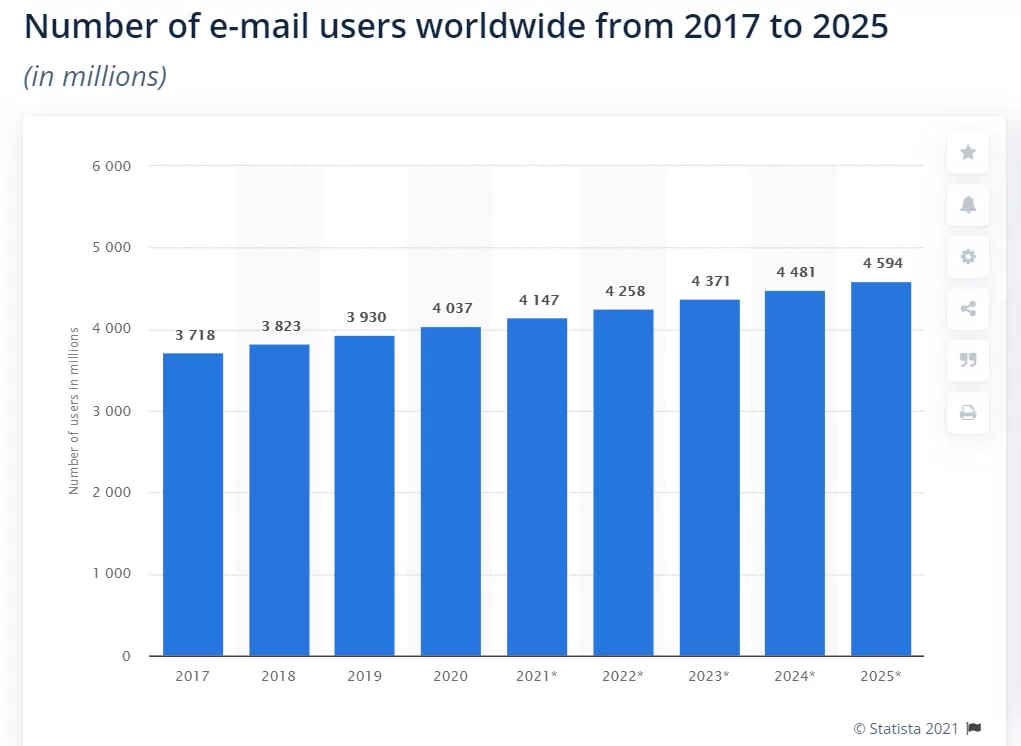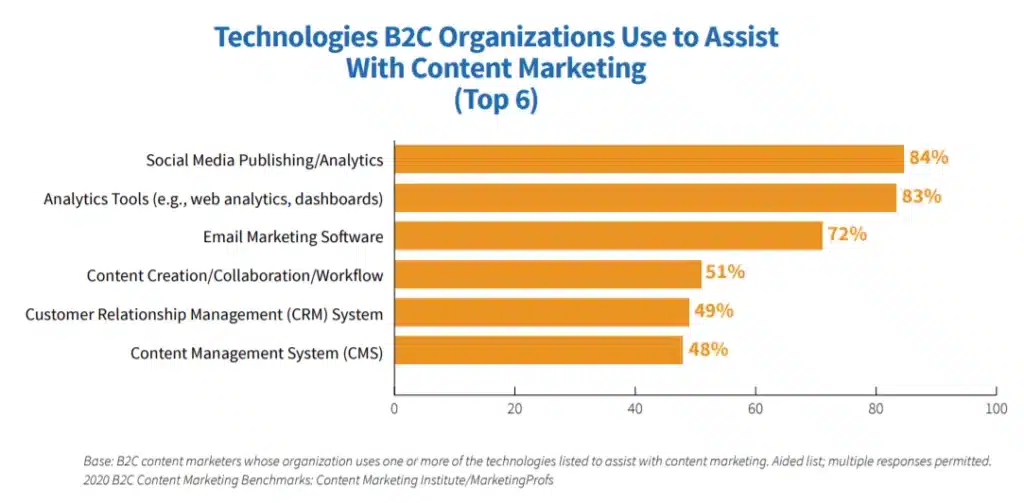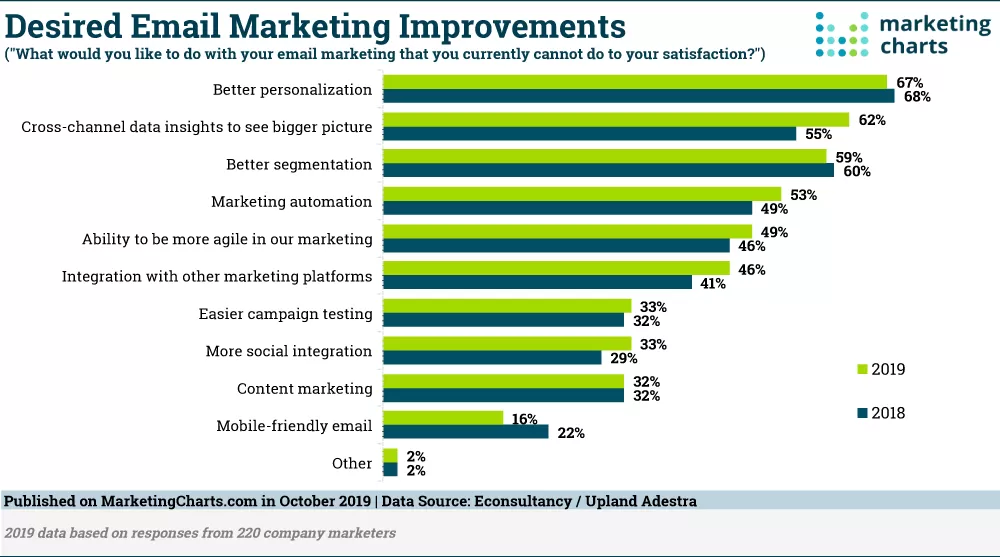Many marketers have emphasised webinars, social media, video marketing, or anything shiny they come across, knowing that trusted revenue streams like email marketing will deliver and they no longer need their focus. But anything new and exciting shouldn’t distract you completely from the fundamental and effective methods of marketing.
Email generates $42 for every $1 spent which is an astounding 4,2000% ROI. So it may be old, but it’s not old hat. Plus, more than three-quarters of marketers report the effectiveness of their emails is improving, or at least holding steady.
So, what is the email marketing landscape of this year, and how can you best use it to your advantage?
Email Marketing Statistics
- There are 4 billion daily email users.
- In 2022, the total number of worldwide email users is estimated to be 4,258 million
- 35% of marketers send their customers 3-5 emails per week.
- 78% of marketers have seen an increase in email engagement over the last 12 months
- 4 out of 5 marketers said they’d rather give up social media than email marketing.
- 89% of marketers use email as the primary channel for generating leads.
- The average click-through rate was 6%.
- The average unsubscribe rate for 2020 was 1%.
- The spam rate average in 2019 was 02%.
- 86% of professionals give priority to email
- In Europe, North America, and APAC, email marketing is the most widely used technology for customer engagement – 6% (compared to 62% produced by content management and 61% shown by social media).
- Countdown timers in emails can boost registrations by 30%.
- Email click-through rates improve by 200% when interactive elements are added
- Sales emails with 200-250 words witness the highest response rate of 19%.
- When text in a call to action button is changed from a second-person viewpoint to a first-person viewpoint, clicks improve by 90%.
- As per 20% of marketers, email design has improved their email engagement
- Including videos in emails can boost click-through rates by 300%.

B2B Email Marketing Statistics
- 81% of B2B marketers say their most used form of content marketing is email newsletters
- 16% of all emails never make it into the inbox
- On average, B2B companies send one email marketing campaign every 25 days.
- 31% of B2B marketers say email newsletters are the best way to nurture leads
- 87% of B2B marketers say email is one of their top free organic distribution channels
- 90% of content marketers say email engagement is the top metric they track to measure content performance.
- 89% of all B2B email campaigns are sent from a company name.
- The second-most common technology B2B organisations use to assist with content marketing is mail marketing software. Roughly 85% of marketers say they work with these tools
- 85% of B2B organisations use email marketing software to help with content distribution
- 93% of B2B marketers distribute content via email
- The average email open rate for B2Bs is 15.1 %.
- 31% of B2B marketers stated that the best way to nurture leads is via email newsletters
- In 2020, the average bounce rate for B2B emails was 1.2.%.
B2C Email Marketing Statistics
- 74% of Baby Boomers think email is the most personal channel to communicate with brands.
- Your audience will reward you with higher open and click rates if you don’t send more than five newsletters a week.
- 60% of retail, e-commerce, and consumer goods and services companies are personalising emails based on past purchases, versus 38% in 2019.
- More than 8 out of 10 people will open a welcome email, generating 4x as many open and 10x as many clicks as other email types.
- The single message autoresponder email had an astonishing 98% open rate and a 37% click-through rate
- Nearly 22% of all email campaigns are opened within the first hour of sending.
- 45% of internet users avoid opening emails from unknown addresses.
- 93% of B2B marketers use email channels for distributing content.
- 72%of customers prefer email as their main channel for business communication.

Email Marketing Demographics
- 99% of email users check their inbox every day, with some checking 20 times a day. Of those people, 58% of consumers check their email first thing in the morning
- 40% of consumers say they have at least 50 unread emails in their inbox.
- Emails sent by independent artists, writers, and performers have the highest open rate at 34.4%, followed by education (34.1%) and travel and tourism (32.6%).
- On average, the highest email click-through rate goes to the Consulting services industry at 25%, with Administrative and Business Support services in second at 20%, and Home and Building services in third at nearly 19%.
- 26% of retail emails bounce, putting it well above the 9% average bounce rate for all industries
- 20% of retail, e-commerce, and consumer goods and services companies are personalizing emails based on gender, race, and ethnicity, versus 11% in 2019.
- 59% of Millennials primarily use their smartphone to check email, while 67% of Generation Z scan their inbox on mobile
- 74% of Baby Boomers think email is the most personal channel to receive communications from brands, followed by 72% of Gen X, 64% of Millennials, and 60% of Gen Z
- 91% of women in the US use email, compared to 89% of men
- Asian Americans are the most popular email users in the US (92%), followed by white users (91%), African American users (88%), Hispanic users (85%), and American Indian or Alaskan Native users (83%).
Automation Statistics
- On average,51% of companies are currently using automation.
- 64%of B2B respondents say that they use email automation
- 47%of marketers are sure that automation is worth the price.
- 5%of responders believe that automation improved the targeting of messages.
- Triggered emails result in 8 times more opens and greater earnings than typical bulk emails.
- The average unsubscribe and spam rates of triggered emails are 58% and 0.06% respectively.
- The best tactics for automation are mapping the customer experience (53%) and using personalised messages (51%).
- Trigger-based emails – also known as transactional emails – outperform batch and nurture ones and are three times more efficient.
- Triggered emails have a 70.5% higher open rate and 152% higher click-through rate than routine email newsletters.
- The three major benefits of email automation for businesses are saving time (30%), lead generation (22%), and an increase in revenue (17%).
Segmentation and Personalisation Statistics
- Marketers who use segmented campaigns note as much as a 760% increase in revenue
- 20% of retail, ecommerce, and consumer goods and services companies are personalising emails based on gender, race, and ethnicity.
- Segmented email campaigns show 50% higher CTR than untargeted campaigns.
- The top 3 reasons for using personalisation in email marketing are improved open rate (82%), higher CTR (75%), and better customer satisfaction (58%).
- The top 3 email marketing tactics are: list segmentation (51%), personalisation (50%), and triggered emails (45%).
- During a SuperOffice email marketing experiment, a segmented email campaign earned a 94% open rate and a 38% CTR, versus a 42% open rate and 4.5% CTR in a non-segmented email campaign.
- Hyper-personalisation out-performs every form of ecommerce marketing combined 20-fold, Deloitte.

Marketers who send segmented campaigns notice a 760% increase in revenue.
- 88% of users agree they are more likely to respond to an email favourably if it looks like it’s been specifically created for them.
- 62% of emails are opened thanks to a personalised subject line.
- By addressing the recipient by their name, you can increase open rates and CTR up to 35%.
- 10% of respondents are annoyed by too little or no personalization.
- According to the respondents, the most frustrating things about personalisation are: recommending items that don’t match their interests (34%), expired offers (24%), name misspelling (15%), inappropriate season or location offers (14%), already purchased promotions (13%).
- Emails with personalized subject lines can increase open rates by 26%.
- Segmented email campaigns caused a 760% increase in revenue.
- Segmented campaigns had 100.95% clicks compared to non-segmented emails globally
- Through proper targeting, marketers can drive three times the revenue per email of broadcast emails
- 74% of marketers said that customer engagement increases through targeted personalisation
Click-Through & Open Rates Statistics
- The average open rate for email newsletters across all industries is 21.33%
- Friday is the best day to send emails, with the highest open (18.9%) and click-through rates (2.7%)
- Emails related to the Government and Non-profit sectors receive the highest open rates
- Plain-text emails perform better, even though most respondents preferred image-based HTML emails.
- 63% of people said that they open an email to find discounts
- Welcome emails have the highest open rates (91.43%) with an average CTR of 26.9%, outperforming other email marketing types.
- The average click-to-open rate for all industries is 14.1%.
Mobile Email Marketing Statistics
- Nearly 1 in 5 email campaigns is not optimised for mobile devices
- 56% of emails are opened on Apple’s iPhone (29%) and Gmail (27%).
- 42.3.% of consumers delete emails that are not optimized for mobile.
- 60% of smartphone users have contacted a business straight from search results.
- 80% of people delete an email if it doesn’t display well on mobile.
- Apple iPhone is the most popular device for reading emails
- Responsive email templates can boost clicks by up to 15%.
- 25% of people who opened an email over their mobile device will view it once again.
- 40% of people aged 18 years or below will always open the email first on their mobile device
It is important to see what happens in reality, retailers, and marketers get duped into believing segmentation is personalisation. Because lumping a load of people in a category together does not work, considering you are in a room of 12 people, you could make significant distinctions between you and them, to the point where anyone telling you that you are all the same, would be furious. It’s the same with your marketing, don’t forget that as recipients open your emails. Segmentation is not personal it is just a smaller and smaller group of diverse tastes and interests. This is the equivalent of sending an email to everyone who bought a red item, or an XL size, it is painful when you measure the effect. Segmenting is marketing marginalisation.
The solution is hyper-personalisation software. Which uses data captured from each consumer as they visit your site, including what they look at, return to most often, etc. It then aligns this with both that individual’s buying history and their perpetual purchases, to rank every SKU on your site by the greatest likelihood of imminent purchase. Instead of waiting to convince that person to buy a specific product, (this season’s stock for example) it uses a predictive analytics algorithm to work out what has been achieved already, and simply capitalise on it.
Thanks to predictive models in email marketing, marketers can now sift through copious amounts of customer data to make key customer engagement decisions. Such data-heavy approaches have given marketers today the opportunity to pinpoint customers’ needs at ‘quantum-esc’ levels, making the future of email marketing brighter than ever!





